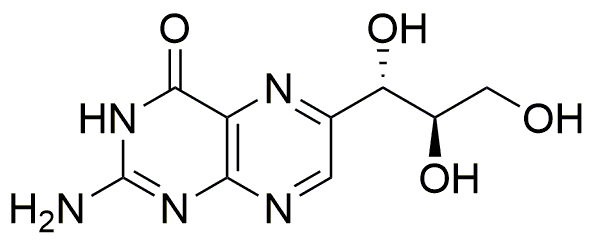D-(+)-Neopterin is widely utilized in research focused on:
- Biomarker for Immune Response: It serves as a valuable biomarker in clinical settings to assess immune system activation, particularly in infectious diseases and autoimmune disorders.
- Research in Neurodegenerative Diseases: Studies have shown its potential role in understanding the pathophysiology of neurodegenerative diseases, helping researchers explore therapeutic targets.
- Diagnostic Tool in Infectious Diseases: D-(+)-Neopterin levels can be measured to aid in the diagnosis and monitoring of various infections, offering a non-invasive method for patient assessment.
- Role in Cancer Research: It is investigated for its implications in cancer biology, where elevated levels may indicate tumor activity or immune response to malignancies.
- Supplement in Nutritional Studies: D-(+)-Neopterin is explored in nutritional research, particularly in relation to folate metabolism and its effects on health outcomes.
General Information
Properties
Safety and Regulations
Applications
D-(+)-Neopterin is widely utilized in research focused on:
- Biomarker for Immune Response: It serves as a valuable biomarker in clinical settings to assess immune system activation, particularly in infectious diseases and autoimmune disorders.
- Research in Neurodegenerative Diseases: Studies have shown its potential role in understanding the pathophysiology of neurodegenerative diseases, helping researchers explore therapeutic targets.
- Diagnostic Tool in Infectious Diseases: D-(+)-Neopterin levels can be measured to aid in the diagnosis and monitoring of various infections, offering a non-invasive method for patient assessment.
- Role in Cancer Research: It is investigated for its implications in cancer biology, where elevated levels may indicate tumor activity or immune response to malignancies.
- Supplement in Nutritional Studies: D-(+)-Neopterin is explored in nutritional research, particularly in relation to folate metabolism and its effects on health outcomes.
Documents
Safety Data Sheets (SDS)
The SDS provides comprehensive safety information on handling, storage, and disposal of the product.
Product Specification (PS)
The PS provides a comprehensive breakdown of the product’s properties, including chemical composition, physical state, purity, and storage requirements. It also details acceptable quality ranges and the product's intended applications.
Certificates of Analysis (COA)
Search for Certificates of Analysis (COA) by entering the products Lot Number. Lot and Batch Numbers can be found on a product’s label following the words ‘Lot’ or ‘Batch’.
*Catalog Number
*Lot Number
Certificates Of Origin (COO)
This COO confirms the country where the product was manufactured, and also details the materials and components used in it and whether it is derived from natural, synthetic, or other specific sources. This certificate may be required for customs, trade, and regulatory compliance.
*Catalog Number
*Lot Number
Safety Data Sheets (SDS)
The SDS provides comprehensive safety information on handling, storage, and disposal of the product.
DownloadProduct Specification (PS)
The PS provides a comprehensive breakdown of the product’s properties, including chemical composition, physical state, purity, and storage requirements. It also details acceptable quality ranges and the product's intended applications.
DownloadCertificates of Analysis (COA)
Search for Certificates of Analysis (COA) by entering the products Lot Number. Lot and Batch Numbers can be found on a product’s label following the words ‘Lot’ or ‘Batch’.
*Catalog Number
*Lot Number
Certificates Of Origin (COO)
This COO confirms the country where the product was manufactured, and also details the materials and components used in it and whether it is derived from natural, synthetic, or other specific sources. This certificate may be required for customs, trade, and regulatory compliance.

